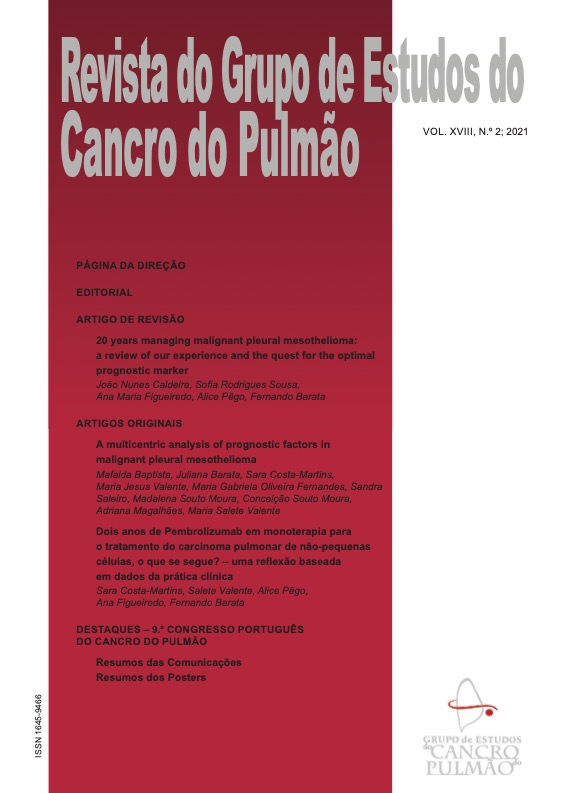20 years managing malignant pleural mesothelioma: a review of our experience and the quest for the optimal prognostic marker
DOI:
https://doi.org/10.32932/gecp.2022.02.018Keywords:
Mesothelioma, malignant, survival analysis, prognosisAbstract
Introduction: Malignant pleural mesothelioma (MPM) is a rare, but aggressive incurable cancer. A variety of prognostic tools have been developed to guide clinicians and patients in the management of MPM regarding the most appropriate therapy and survival time.Objectives: To evaluate the usefulness of the Brims’ decision tree analysis, the EORTC prognostic score, the CALGB prognostic groups, the modified Glasgow Prognostic Score (mGPS), and the LENT prognostic score in our MPM patients.
Methods: Local retrospective database analysis of patients with MPM diagnosed between 2000 and 2020. The different prognostic scores were applied and MPM group risks’ evolution was analyzed. Statistical analysis was performed with IBM® SPSS® Statistics 25.
Results: A total of 67 patients were evaluated (55 males, 82.1%). Epithelioid MPM was the commonest histological type (51 patients, 76.1%). Median overall survival (OS) was 11 months (IQR 23) and median progression free-survival (PFS) was 7 months (IQR 12.5). Survival distributions were statistically significantly different for the Brims’ and the mGPS’ groups (respectively, χ2 = 7.188, p = .027, and χ2 = 6.46, p = .04). For EORTC, CALGB and LENT score, there were not statistically significant differences in survival distributions (respectively, χ2 =.57, p = .811; χ2 = 7.978, p = .157; and χ2 = 1.23, p = .267). Brims’ model and mGPS statistically significantly predicted OS (respectively, F(1,57) = 11.1, p < 0.01, and F(1,32) = 6.846, p = .01). EORTC, CALGB and LENT failed to statistically significantly predict OS (respectively, F(1,44) = .003, p = .955; F(1.43) = .722, p = 0.4; and F(1,14) = 1.193, p = .293).
Conclusion: The small number of patients included and missing data for some parameters are limitations of our analysis. However, to our knowledge, this was the first study and the largest cohort to address MPM prognostic scores in our country. In our cohort, the Brims’ model and mGPS were useful in predicting survival. Both are simple tools with easily accessible parameters and should be considered for clinical practice.
Downloads
References
Kim RY, Sterman DH, Haas AR. Malignant Mesothelioma: Has Anything Changed? Semin Respir Crit Care Med. 2019;40(3):347-360.
Asciak R, George V, Rahman NM. Update on biology and management of mesothelioma. Eur Respir Rev. 2021;30(159):1-13.
Pinato DJ, Mauri FA, Ramakrishnan R, Wahab L, Lloyd T, Sharma R. Inflammation-based prognostic indices in malignant pleural mesothelioma. J Thorac Oncol. 2012;7(3):587-594.
Brims FJH, Maskell NA. Prognostic factors for malignant pleural mesothelioma. Curr Respir Care Rep. 2013;2:100-108.
Motta AB, Pinheiro G, Antonângelo L, et al. Marcadores morfológicos de prognóstico no mesotelioma maligno: um estudo de 58 casos. J Bras Pneumol. 2006;32(4):322-332.
Woolhouse I, Bishop L, Darlison L, et al. British Thoracic Society Guideline for the investigation and management of malignant pleural mesothelioma. Thorax. 2018;73(March):i1-i30.
Brims FJH, Meniawy TM, Duffus I, et al. A novel clinical prediction model for prognosis in malignant pleural mesothelioma using decision tree analysis. J Thorac Oncol. 2016;11(4):573-582.
Curran BD, Sahmoud T, Therasse P, Meerbeeck J Van, Postmus PE, Giaccone G. Prognostic Factors in Patients With Pleural Mesothelioma: The European Organization for Research and Treatment of Cancer Experience. J Clin Oncol. 1998;16(1):145-152.
Herndon JE, Green MR, Chahinian AP, Corson JM, Suzuki Y, Vogelzang NJ. Factors predictive of survival among 337 patients with mesothelioma treated between 1984 and 1994 by the Cancer and Leukemia Group B. Chest. 1998;113(3):723-731.
McMillan DC. An inflammation-based prognostic score and its role in the nutrition-based management of patients with cancer. Proc Nutr Soc. 2008;67(3):257-262.
Proctor MJ, Morrison DS, Talwar D, et al. An inflammation-based prognostic score (mGPS) predicts cancer survival independent of tumour site: A Glasgow Inflammation Outcome Study. Br J Cancer. 2011;104(4):726-734.
Clive AO, Kahan BC, Hooper CE, et al. Predicting survival in malignant pleural effusion: development and validation of the LENT prognostic score. Thorax. 2014;69:1098-1104.
Scherpereel A, Opitz I, Berghmans T, et al. ERS / ESTS / EACTS / ESTRO guidelines for the management of malignant pleural mesothelioma. Eur Respir J. 2020;55(6):1900953.
Fernandes A. Epidemiologia do mesotelioma. Revista GECP. 2015;XII(2):25-30.
Baptista M, Fernandes G, Magalhães A, et al. Mesotelioma pleural maligno: casuística de 20 anos. Pulmonology. 2020;26((Esp Cong 1)):5-59.
Baas P, Fennell D, Kerr KM, van Schil PE, Haas RL, Peters S. Malignant pleural mesothelioma: ESMO Clinical Practice Guidelines for diagnosis, treatment and follow-up. Ann Oncol. 2015;26(July):v31-v39.
Chen N, Liu S, Huang L, et al. Prognostic significance of neutrophil-to-lymphocyte ratio in patients with malignant pleural mesothelioma: A meta-analysis. Oncotarget. 2017;8(34):57460-57469.
Meniawy TM, Creaney J, Lake RA, Nowak AK. Existing models, but not neutrophil-to-lymphocyte ratio, are prognostic in malignant mesothelioma. Br J Cancer. 2013;109(7):1813-1820.
Kataoka Y, Yamamoto Y, Otsuki T, et al. A new prognostic index for overall survival in malignant pleural mesothelioma: The rPHS (regimen, PS, histology or stage) index. Jpn J Clin Oncol. 2015;45(6):562-568.
Downloads
Published
Issue
Section
License
Copyright (c) 2024 Author(s) (or their employer(s)) and THORAC 2024

This work is licensed under a Creative Commons Attribution-NonCommercial 4.0 International License.





